48 years on from being voted out of the EFL, Barrow shall return whenever League Two begin their new season. The man guiding them: Ian Evatt. At just 38, Evatt has energised the club – Barrow have broken attendance records this campaign – seeing them be crowned champions of the National League on points per game after clubs voted to curtail the season. This achievement is all the more impressive when you consider the situation Evatt inherited; Barrow only had seven players available.
Evatt has also brought in a style not seen in these depths of English football. Inspired by his time playing under Ian Holloway at Blackpool, as well as studying Pep Guardiola’s methods at Manchester City, Barrow play attacking, expansive football. Unlike many teams at this level, they have a focus on retaining possession and probing for incisive passes – resulting in their fans nicknaming them ‘Barrowcelona‘.
In this tactical analysis in the form of a scout report I will use analysis to identify the tactics used by Ian Evatt in his Barrow team.
Build-up tactics
Evatt has predominantly deployed variations of formations that employ three at the back. The most common system utilised is the 3-5-2. This effectively allows him to use two strikers – as is the norm in the lower divisions in England – whilst having a solid base in the first phase of build-up.
Scott Quigley is the top scorer in the league with 20, while his regular partner Dior Angus has 10. Moreover, John Rooney has the freedom to venture forward in order to support the forwards; he has a quite remarkable 17 goals to his name from central-midfield.
One of the fundamentals of positional play, and thus Evatt’s tactical philosophy, as he has spoken about its influence upon him, is creating numerical superiority. In the National League, many teams will opt for a basic defensive structure, rarely conducting a high press. Therefore, these three centre-backs are afforded time on the ball, to assess their options and manipulate the opposition shape so to create an optimum angle for a penetrative pass. The extra coverage of the field you have with this compared to just two-centre-backs means the ‘outer’ centre-backs can occupy the half-space, while having cover behind, thus likely meaning increased passing lanes into more dangerous zones. Also, this secure base allows rotations and overloads between the lines higher up the pitch to occur, for dismarking purposes, made better by the lateral stretching of defensive lines due to the increased coverage. Furthermore, the double pivot rotates vertically to ensure optimum spacing – to avoid having double occupation of the pivot space. Essentially, because of the more optimum spacing in deeper positions, superiorities can be generated in more offensive areas.
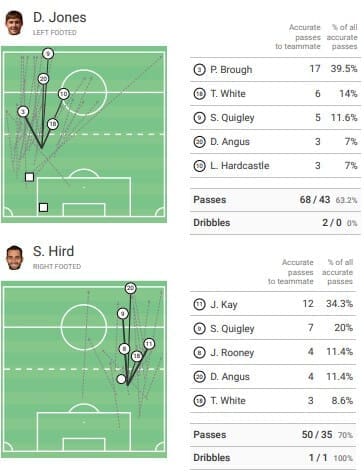
The image above illustrates the passing patterns of Dan Jones and Sam Hird, the left-centre-back and right-centre-back respectively. What is noticeable is how frequently they seek to access their teammates in the half-space. This area is intrinsically related to having an offensive threat, as its geographical location means there are usually several passing options upon receiving possession.
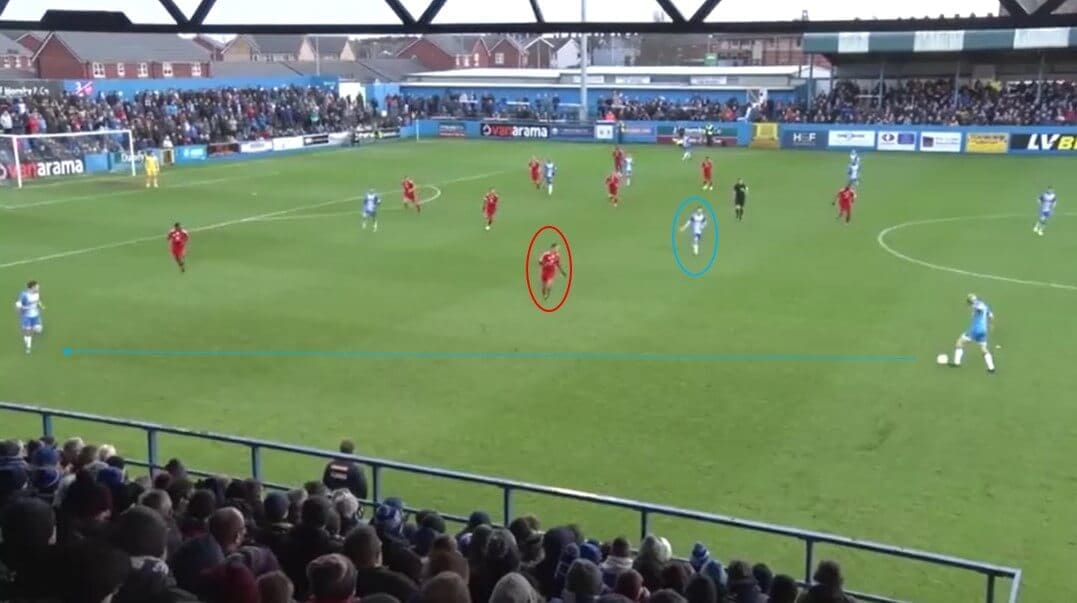
We can see the benefits of this occupation above. The wide-centre-back’s positioning forces Ebbsfleet’s winger to come wider and engage. Width is being provided by the wing-back, who has created a passing lane towards the touchline. In addition to this, there is a midfield option and Quigley is making his way across into the half-space. Subsequently, a decisional problem has been created for the aforementioned winger due to the occupation of various relevant areas and he can be bypassed simply.
I
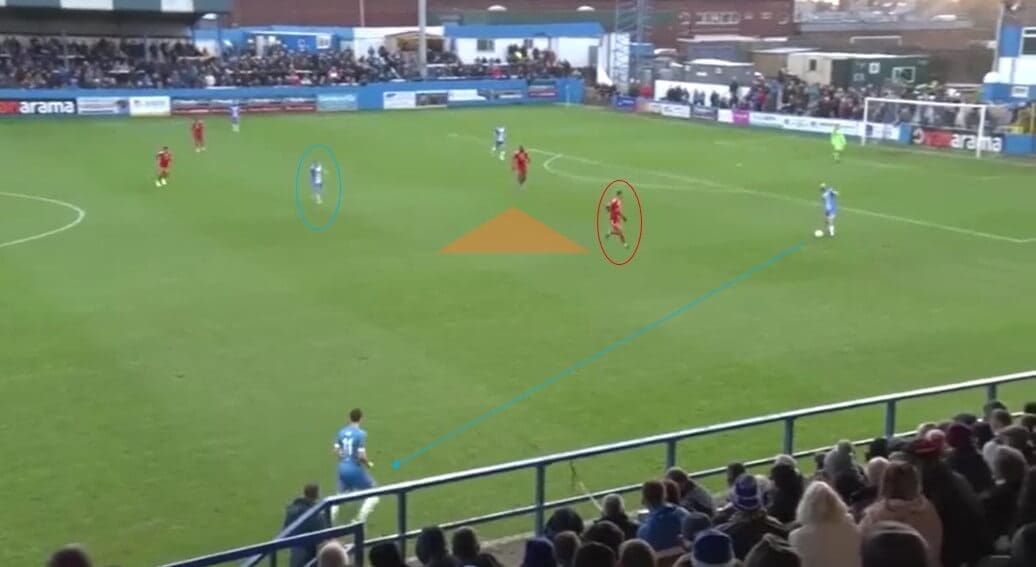
In this next example there is a similar scenario. Here, the Ebbsfleet player has greater pressing distance due to the three centre-backs, allowing Taylor to execute a passing to the left-wing-back. The defender also needs to be wary of the pivot who is likely occupying his attention to some extent.
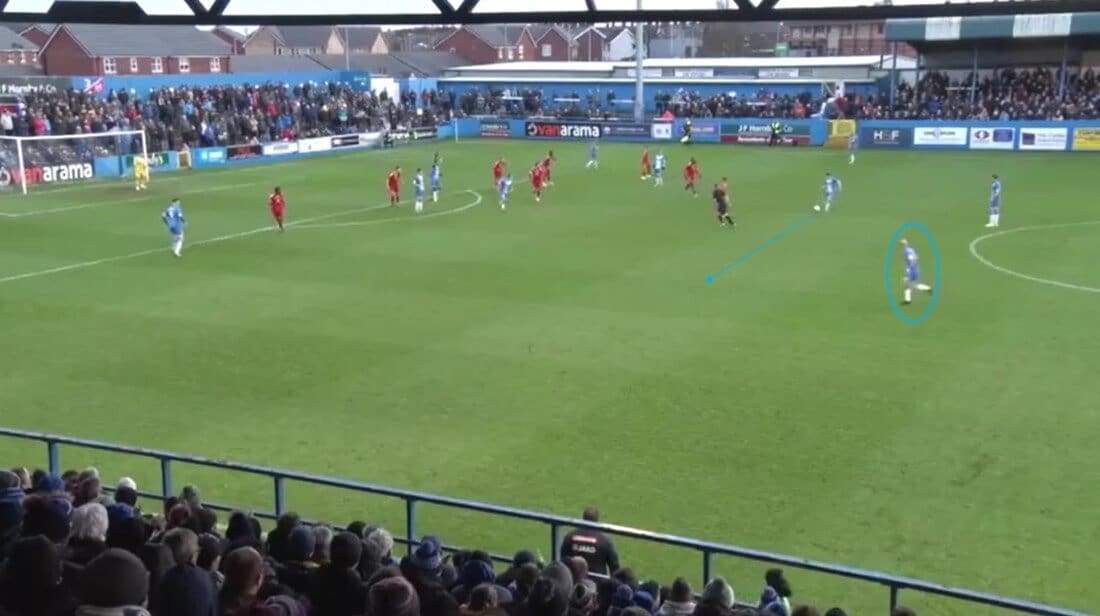
Higher up the pitch the centre-backs can be used to create overloads in an area that has previously been underloaded. Here above, Ebbsfleet have been disproportionately attracted to the right flank giving Taylor undue space. The 33-year-old can then advance into unoccupied space to receive. As a result of this offensive movement Ebbsfleet’s right-back can be overloaded either through an overlap or underlap – although it’s important for his teammates to rotate around to keep an optimal rest defence.
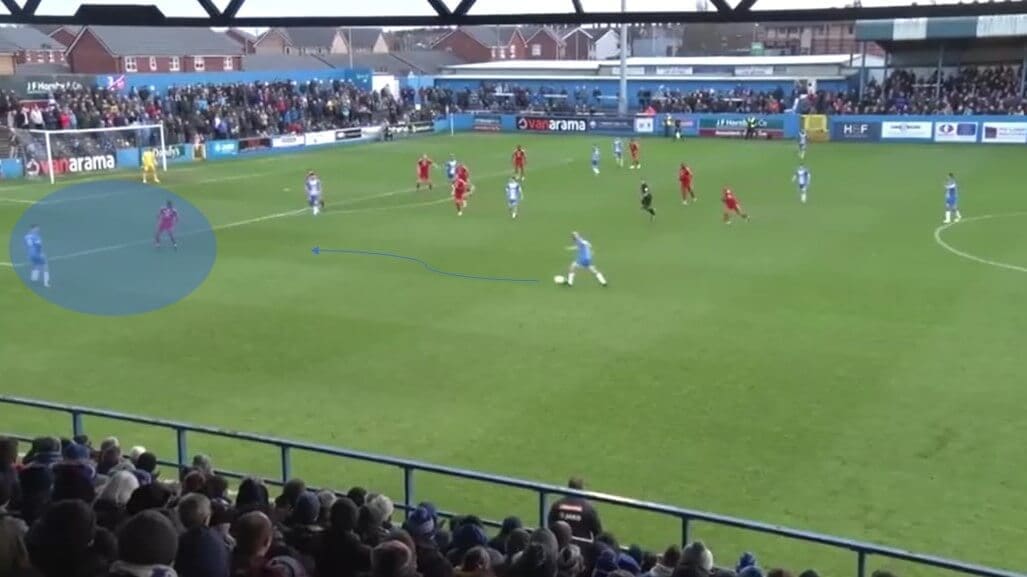
Wing-focussed pressing
The central occupation Barrow have in the attacking formations – having two strikers and occasionally a ‘10’ – results in the opposition having their build-up guided to wide areas. In this situation the touchline can effectively act as an additional defender thereby pinning players in during a press, making it difficult to bypass.
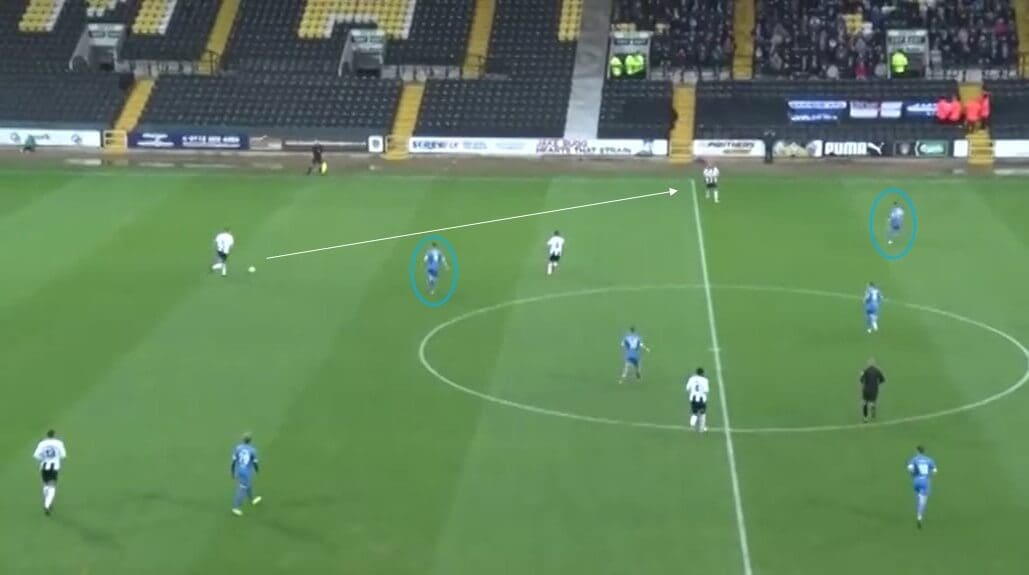
We can see a perfect example of this here above, the offensive trident has control of Notts County’s potential ball progressors, whilst allowing their centre-back freedom and time, but guiding him into a pressing trap out wide where they can collapse and overwhelm, causing a turnover. In the next image below, the effects of this are visible. The ball has naturally found its way to the Notts County left-back. This is a pressing trigger for Barrow. Six players shift across to maintain compactness, as well as them being on alternative lines, both vertically and horizontally. They also concentrate on protecting the half-space, this is especially important as without this, shifting issues can be exploited via a quick switch of play.
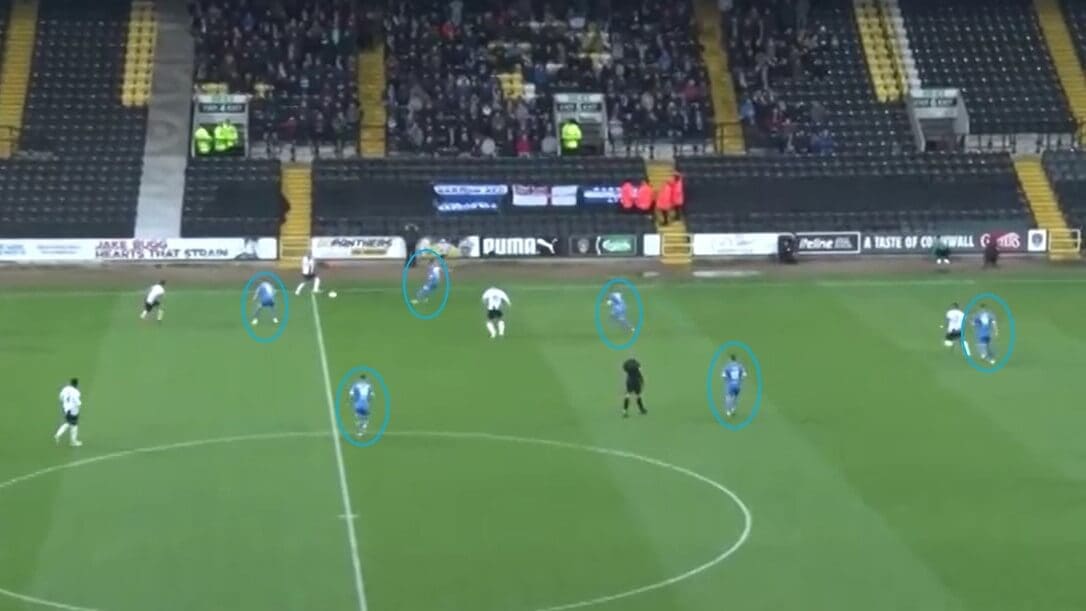
Here, again below, the staggered compact, defensive shape is evident out-wide. A midfielder has come into the half-space to shut off the passing lane forward, while a centre-back can follow the striker into the channel. This is a benefit of Evatt’s system; three centre-backs provide increased coverage so can move wider with less risk attached.
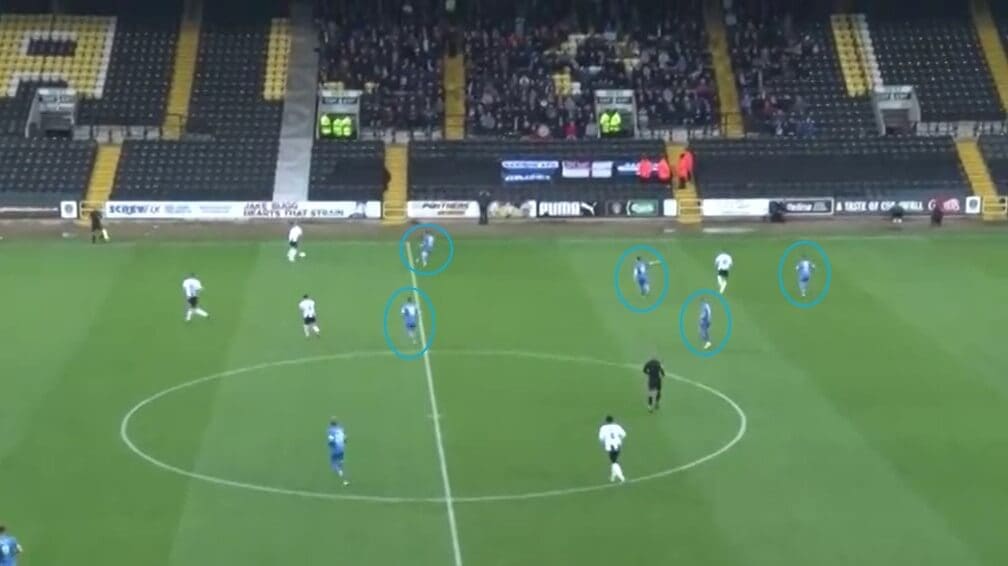
Once more below we can see how despite the wing-back pushing up to apply pressure, space is not vacated too much. Additionally, there are two Barrow players situated within the half-space, further blocking off inside passes.
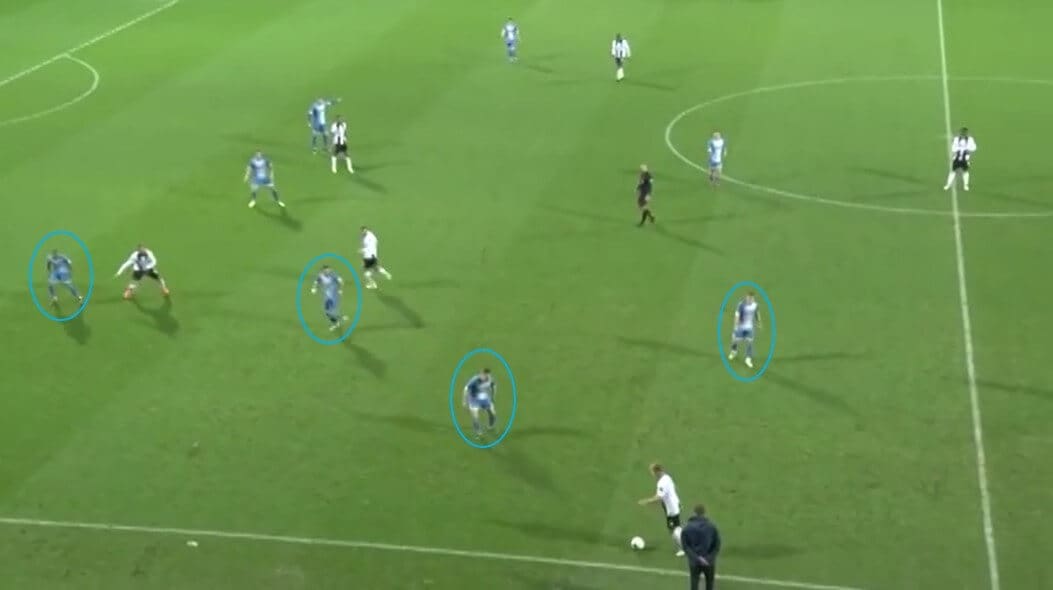
Naturally, concentrating on achieving turnovers in these types of areas has secondary effects. Shifting issues can develop even with the smallest of mistakes. The ball-far players need to tuck in to avoid gaps appearing both within and between defensive lines. Particularly with this defensive principle being organised during a defensive transition is vital. Indeed, the chaotic nature of the National League does make it hard to have an optimal shape the majority of the time. In this image below there has been a loss of possession, however, due to their wing focus, there is a lack of occupation in the midfield. Whilst it is necessary to utilise width when attacking a structured rest defence is also a key component, like Liverpool show routinely. Here we see how a simple vertical pass can bypass several Barrow players, who then have poor body-orientation.
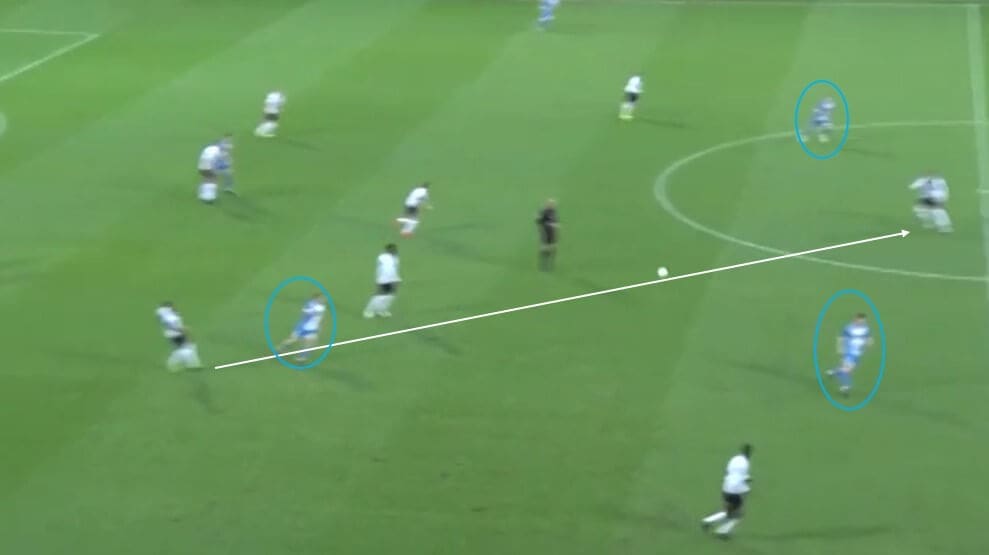
Final third strategy
In more advanced areas the influence of positional play principles is evident within Barrow’s offensive structure and movements. For instance, they often have players situated between the lines in order to overload the defence who have to be aware of the striking duo. The three midfielder formation also gives tactical flexibility in how they are located. For example, whether a ‘10’ could be picked versus weaker teams, especially at home. Barrow have scored 68 goals this season – the most in the league – demonstrating their potency.
Positioning yourself between the lines will subsequently occupy a marker. They cannot be proactive in their defending as any vacated space will be exploited; they are being pinned. Therefore, with the correct spacing, teammates can become free elsewhere – we can see this occurring below. The opposition right-back has his attention to the player immediately in front of him who is making a helpful diagonal run centrally. As a result, the Barrow player wide left is in a large amount of space, and able to control and attack the aforementioned full-back. This also links to how Barrow seek to isolate their wide players after an initial overload on the opposite flank – this was apparent in the first section of the analysis.
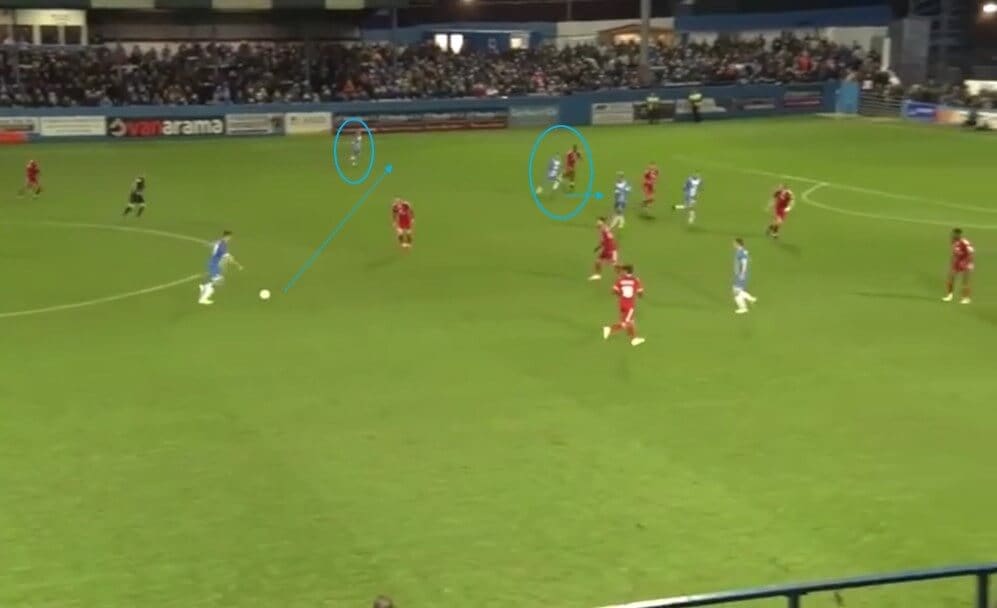
There are references here to positional play here as well: occupation of the five vertical lanes, thus overloading a four-man defensive line, inevitably creating space somewhere. Although Barrow’s preferred 3-5-2 formation doesn’t lend itself to having five men in the most advanced line, optimal positioning has the potential to occupy two opposition players, such as a striker with two centre-backs.

A similar example is shown above. There is a Barrow player situated in the half-space between the opponent’s full-back and centre-back. Because of this the full-back cannot move out to engage the Barrow wing-back. In the centre of the pitch the two forwards are well-positioned in-between the centre-backs on their blindsides – the body language of one shows how he has them both in his vicinity.
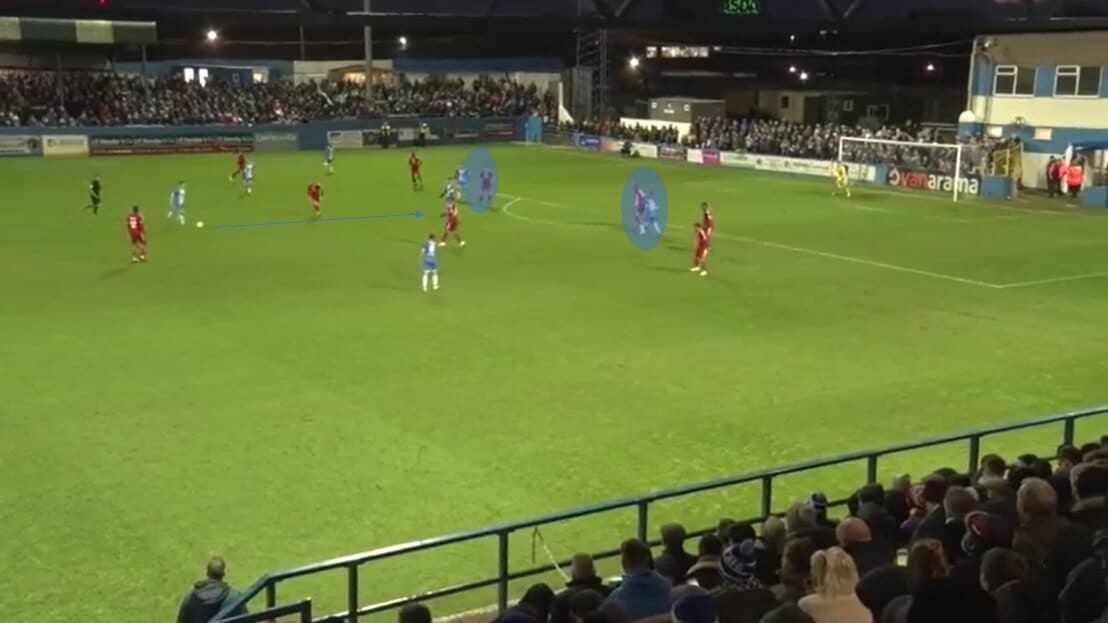
We can see here again how the opponent’s midfielder can’t cover the central passing lane. Furthermore, the centre-backs are restricted in their movements because of the presence of the strikers. This leads to a simple pass through the second line.
Conclusion
Simply put, the job Evatt has done is incredible. In his first full-time job, he has transformed the club getting them promoted on the bottom six budget whilst playing attractive, attacking football. His philosophy is admirable, in a football sense but also psychologically. For instance, Evatt insists his side runs into the changing rooms at half-time to emphasise their mentality to the opposition. While writing this article, rumours have gathered pace about Evatt’s future at the Cumbrian side. It now seems he is set to move to recently relegated Bolton Wanderers. It will be fascinating to see whether he can repeat the job.






Comments